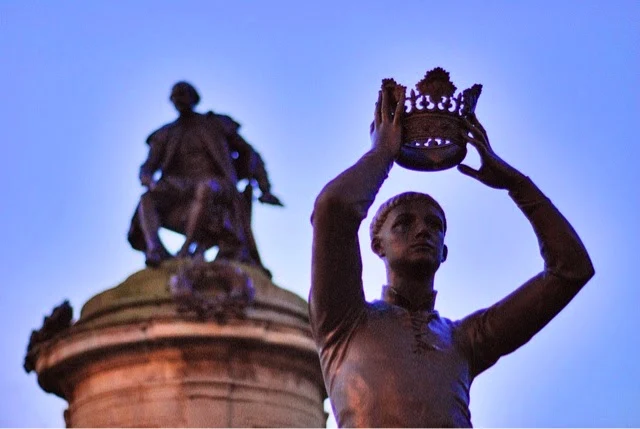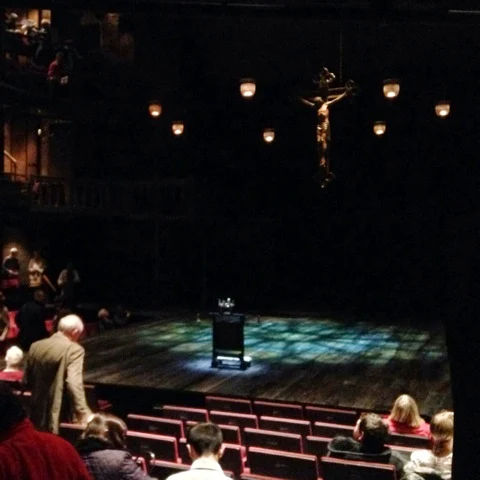I know that others are capable of addressing this inquiry more objectively. This, however, is a personal statement: that is, therefore, slightly more subjective. However, I think it is important that those making the final decision regarding this proposed development understand why Tysoe is so deeply valued and loved (and therefore why so many residents have objected vehemently to this proposal); what it feels like to live here; and why it should be protected from this mass onslaught of unsuitable and unsustainable development.
I have only lived in Tysoe for a few years, but have become so attached to the place, its people, spirit, identity and community, that I now write a blog, online, as The Bard of Tysoe – covering many aspects of village (and local) life, in an attempt to capture the unique spirit of the place. It is three of those “many aspects” that I would like to address here:
- its personal attachment (i.e. the attraction of the village to both incomers and long-time residents);
- the threats the cohesion of this community faces, were it to expand rapidly, rather than continue evolving, as it has done for centuries; and
- the total lack of sustainability such an expansion would force on the village and its heritage.
Before I continue, though, I must stress that I – along with all the other villagers I have spoken to – would not want to deprive others of living in this wonderful place. We know that we have to grow. It is just that the proposed development is too large, too sudden, too concentrated; would remove a crucial part of our heritage; and would be damaging for future generations, because of the lack of regard it has for the negative impact it will have on the earth we live on.
¶
About three-and-a-half years ago – on our way to somewhere-else – our car broke down in Stratford-upon-Avon. Whilst the car was being repaired, we wandered into town, and spotted a picture of the house we now live in, in the window of an estate agent. Objectively, there is little that is remarkable about our home. Admittedly, for a building of its age, it has a bit of character – but the garden is smaller than we would have liked; and it doesn’t have a garage. One thing it does have going for it, though, is that it is in Tysoe.
Having lived in a small village, before, I knew how important the post office and shop would be; how fundamental it is that there is a pub, a village hall, a doctors’ surgery; how you soon get to know your neighbours – and trust them. What I hadn’t expected was the amazing strength and sense of identity and community the three villages that make up Tysoe jointly possess – something that continues to become more apparent (and amaze) with each passing day.
The campaign to fight this proposed development of eighty houses on Oxhill Road – which started last September – typifies this; and I must admit to being overwhelmed by the sense of purpose, unity and duty that drives those motivated to ‘do something about it’. It seems I am not the only one who finds this place so very special.
For health reasons, I spend as much time as I can walking – whether it be by Shakespeare’s Avon; or through his supposed poaching ground of Charlecote. But, whatever the undoubted attractions of those places, I prefer just to wander around the local byways – maybe up to the windmill; to Upton House; or across the fields to Oxhill. But I am at my most content just sitting in the churchyard, knowing this is my village – and that this is where I will stay. To paraphrase Touchstone, in As You Like It – “When I am at home, I am in a better place.”
¶
When I write my blog, I keep coming back to two words: “community” and “identity”. They (like sustainability – which I will talk about in a moment…) can be hard to define; yet are, at the same time, utterly recognizable…. But my largest worry at the moment is that the village’s community and allied identity will be unsustainable in the face of the onslaught of such an overwhelming, and dense, addition to the local built environment (and probably in a style more suited to the urban than the rural), as well as the consequent huge population increase (again, probably more suited to the urban than the rural).
Every time I pass, or walk through, that field on Oxhill Road, therefore, I cannot help but imagine the huge carbuncle that would result from this development: a terrible scar being opened in the ancient earth; followed by horrendous ‘surgery’ – taking place over two or three years – polluting the village with noise, dirt, congestion, and perpetual, unsustainable, damage.
The proposal is utterly disproportionate in scale; utterly unsuitable in design and density; and would increase the number of houses in Middle and Upper Tysoe by over 20%; and the population by around 30%… – causing undue harm to the local landscape, its important environmental and historical assets, and the people who live here: now, and in the future.
In a council district where a sizable proportion of the houses are holiday lets and bed-and-breakfasts – and where the average house price is amongst the most expensive in the region – it seems ludicrous, to me, to build such a concentration of houses that will be unaffordable to those who truly want and need to live here (for example, our children…); and so far away from any centres of employment – especially as Tysoe is served poorly by public transport. There are also over one thousand empty houses in Stratford District that could contribute to the council’s five-year housing supply – reducing the perceived need to build on valuable agricultural land.
¶
Because of all this, I have a feeling that this ‘fourth Tysoe’ would never truly integrate with the rest of the village – not because we are unwelcoming: after my short time here, I feel a true part of the community (although the new residents would soon become aware of our fight – which they would then, of course, perceive was against them…) – but because it will not have evolved from what already exists. It would not be a true, integrated part of the village – even though directly connected – but stuck on badly: like some young child’s blindfolded attempt at pinning the tail on the donkey. It is completely without context and suitability.
It would, however – whilst imposing its lack of sustainability on all of us – rely on its connection with the rest of the village (its ‘better half’) for its infrastructure and services; its prosperity and survival (although I do not believe it would contribute much to the local economy…) – even though it had caused the village such irreparable harm.
In contrast, fifty to seventy-five houses being developed over the next seventeen years – as envisaged in Stratford District Council’s draft Core Strategy – will be more manageable; and will – with Tysoe’s Neighbourhood Plan in place – build sensibly and meaningfully on the way the village has grown, over the centuries, with just a few new houses appearing every year.
¶
As we keep being told:
At the heart of the National Planning Policy Framework is a presumption in favour of sustainable development, which should be seen as a golden thread running through both plan-making and decision-taking.
What people seem to gloss over, though, is an understanding of that word “sustainable”; and, in my experience, for many, sustainability can be somewhat difficult to describe.
However, the dictionary defines it as…
…that which is capable of being sustained [which is a little circular in its reasoning]; and, in ecology, the amount or degree to which the earth’s resources may be exploited without damage to the environment.
In a way, both of these aspects are important when it comes to assessing how a new, large housing development will affect the village – which is why they are (when read carefully, and understood properly) at the heart of the major legislative requirements for development in this country.
Using this definition, there are immediate and obvious grounds for refusing Gladman’s proposals:
- The council’s draft Core Strategy states that developments should cause no significant increase in traffic on rural roads: and yet a sudden influx of eighty households will mean that most of those will work outside the parish; which, in turn, means a large increase in commuting and service traffic – through both Oxhill and Tysoe. Anyone who uses these roads will tell you that they are narrow and unsafe, and are already blocked at peak times. This increase in the number of cars will not only affect existing traffic – which includes a large number of agricultural vehicles, crucial to the local economy – but cyclists, horse-riders, and pedestrians: including parents and small children on their way to and from Tysoe Primary School and Tysoe Pre-School.
- The village’s surgery is already at full capacity: and, therefore, there would be no healthcare facilities for the large number of incoming residents.
- As is well-known, local sewage and surface water management facilities are already over-capacity; and the part of Tysoe under consideration – like much of the village – is already subject to frequent flooding.
- Not only will the new houses be visible from the Edgehill escarpment – which is part of the Area of Outstanding Natural Beauty bordering the village – but it will form a major incursion across the village boundary into the countryside – in contravention of the council’s Core Strategy policy: which states that any development proposals should avoid such high-quality land as the ridge-and-furrow field the development will eradicate: land that is of ecological and archaeological value, locally and nationally.
¶
It is not hard to spot, as you wander around the parish, that Tysoe is blessed with a relatively large number of remaining ridge-and-furrow fields. However, there is only one field that is still directly attached to Tysoe Manor – itself a Grade II* listed building… – and that is the field currently under threat.
Why is this important?
Well, in the Middle Ages, this field would almost certainly have been owned by the lord of Tysoe Manor; and farmed by his peasant tenants, using the open field system. Each such farmer would ‘rent’ a number of strips (by giving a proportion of his crops to his lordship) – although probably not together, but scattered around the manorial fields – his medieval plough (probably shared with others) turning the soil over and over, year in, year out. And, with his neighbours ploughing in the opposite direction, over time, this gradually moved the increasingly fertile earth inwards, from the edge of the strip (the furrow), causing it to build up in the middle (the ridge). And, as this creates such regular ditches, it seems likely that this process was also used to improve drainage for the farmers and their crops.
These great open medieval fields were worked by the peasants as a community, though; and, at certain times of year – such as harvest – the whole village would come together. Although, in the end, of course, little could be done against the powers of the plague, and then enclosure – where landowners, with the full backing of the Government, could ‘enclose’ their land, and bring it into profitable use – profitable for them, anyway.
This field has not changed in hundreds and hundreds of years. It is living history. And it is a sobering thought that our ancestors would have seen what we see now. There are powers, though, now, to stop our heritage suffering more vandalism – and they are enshrined in the NPPF and other planning laws.
¶
When Joseph Ashby – Tysoe’s most famous son – was alive, the Act of Parliament that was passed in April 1796 “for the enclosure of the open fields of Tysoe” – almost the last parish in the area to succumb: and, therefore, with little apparent resistance… – was a recent and living memory; the end of an era. Many of the pre-enclosure rituals were still enacted at harvest, therefore; and many villagers were still aware of the location of their family’s ‘lands’, or ploughing ridges – a passive, subtle, but behindhand rebellion against “a visible sign and symbol that rampant family and individual power had gained a complete victory over the civic community.”
How sad it would be if the present villagers were to have similar memories for such a vital piece of our heritage – even though we had resisted its eradication so strongly; and we had known that the law should have been on our side.
¶
One last thought on sustainability. Sustainable development (which is what we obviously want for our village – as we know we have to keep on growing, as I have said…) is itself defined in many ways – but probably the most frequently cited is from Our Common Future, also known as the United Nations’ Brundtland Report:
Sustainable development is development that meets the needs of the present without compromising the ability of future generations to meet their own needs.
Apply this to the proposal – and it fails at every step.
¶
I don’t know if every resident feels the same way – I know that many do… – but I chose to live in Tysoe partly because of the lure of its isolation. (For some, I know, such isolation can be a ball-and-chain around their ankles: a threat to their physical and mental health.) However, I choose to stay here because of that isolation; the village’s utterly wonderful, large moat of countryside; and its intrinsic, unique sense of community and identity. (Those words again.)
I don’t know if it really is “the most rural village in Warwickshire”, as has been claimed – it certainly feels it, sometimes (thank goodness). What I do know is that I don’t want to be walking down Oxhill Road, with a future small grandchild in hand, explaining what the field that then holds eighty houses was; what it meant.
This may sound, to some, like that dreaded word ‘nimbyism’ – but I hope that the reasons I have outlined in my speech (and the evidence others have – and will – put forward) confirm that this is not the case.
There are so many better ways of dealing with the current – albeit slowing – rates of population growth than simply dumping eighty unsuitable, unsustainable, urban-style boxes of ticky-tacky in a field far removed from anywhere where people work and shop.
I have seen villages that have stagnated, and have therefore lost their hearts. I have seen villages rapidly transformed into towns, and therefore lose their identity and sense of community: fragmenting into places where residents neither know – or can rely on – their neighbours. I want neither of these fates to befall Tysoe – or any other village – nor do I want its growth to be part of the ruination of this planet, and its environment, that threatens the wellbeing of our children and grandchildren, and their children and grandchildren.

















